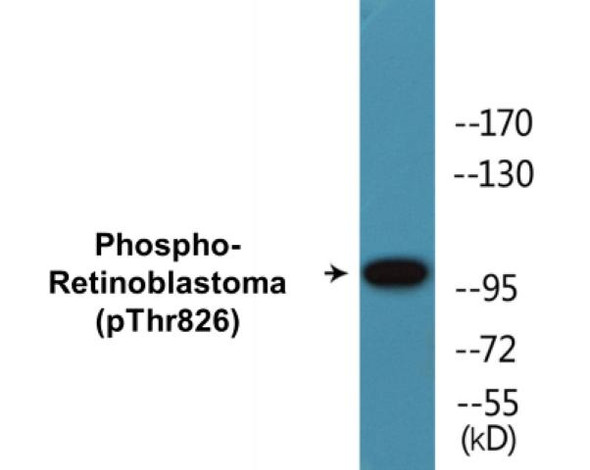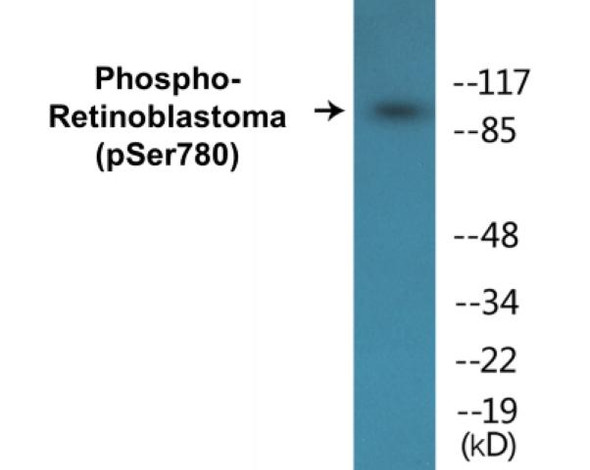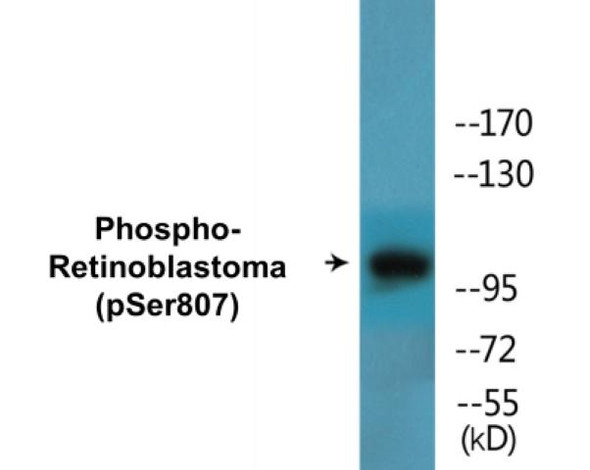Description
Retinoblastoma (Phospho-Ser795)Colorimetric Cell-Based ELISA Kit
The Retinoblastoma Phospho-Ser795 Colorimetric Cell-Based ELISA Kit is specifically designed for the accurate detection of phosphorylated Retinoblastoma protein at Serine 795 levels in cell lysates. This kit provides high sensitivity and specificity, ensuring reliable and reproducible results for researchers studying cell signaling pathways and potential therapeutic targets in cancer research.The Retinoblastoma protein is a key tumor suppressor protein that regulates cell cycle progression and plays a critical role in preventing uncontrolled cell growth and tumor formation. Phosphorylation of the Retinoblastoma protein at Serine 795 is known to impact its function and can contribute to the development and progression of various cancer types, including retinoblastoma.
By accurately measuring the levels of phosphorylated Retinoblastoma protein at Serine 795, researchers can gain valuable insights into the signaling pathways involved in cancer development and progression. This kit is essential for studying the molecular mechanisms underlying retinoblastoma and other cancers, as well as for identifying potential therapeutic targets for the treatment of these diseases.
| Product Name: | Retinoblastoma (Phospho-Ser795) Colorimetric Cell-Based ELISA |
| Product Code: | CBCAB01603 |
| ELISA Type: | Cell-Based |
| Target: | Retinoblastoma (Phospho-Ser795) |
| Reactivity: | Human, Mouse, Rat |
| Dynamic Range: | > 5000 Cells |
| Detection Method: | Colorimetric 450 nm |
| Format: | 2 x 96-Well Microplates |
The Retinoblastoma (Phospho-Ser795) Colorimetric Cell-Based ELISA Kit is a convenient, lysate-free, high throughput and sensitive assay kit that can detect Retinoblastoma protein phosphorylation and expression profile in cells. The kit can be used for measuring the relative amounts of phosphorylated Retinoblastoma in cultured cells as well as screening for the effects that various treatments, inhibitors (ie. siRNA or chemicals), or activators have on Retinoblastoma phosphorylation.
Qualitative determination of Retinoblastoma (Phospho-Ser795) concentration is achieved by an indirect ELISA format. In essence, Retinoblastoma (Phospho-Ser795) is captured by Retinoblastoma (Phospho-Ser795)-specific primary (1ø) antibodies while the HRP-conjugated secondary (2ø) antibodies bind the Fc region of the 1ø antibody. Through this binding, the HRP enzyme conjugated to the 2ø antibody can catalyze a colorimetric reaction upon substrate addition. Due to the qualitative nature of the Cell-Based ELISA, multiple normalization methods are needed:
| 1. | A monoclonal antibody specific for human GAPDH is included to serve as an internal positive control in normalizing the target absorbance values. |
| 2. | Following the colorimetric measurement of HRP activity via substrate addition, the Crystal Violet whole-cell staining method may be used to determine cell density. After staining, the results can be analysed by normalizing the absorbance values to cell amounts, by which the plating difference can be adjusted. |
| Database Information: | Gene ID: 5925, UniProt ID: P06400, OMIM: 109800/180200/259500, Unigene: Hs.408528 |
| Gene Symbol: | RB1 |
| Sub Type: | Phospho |
| UniProt Protein Function: | Rb: retinoblastoma tumor suppressor protein regulates cell proliferation by controlling progression through the G1-phase restriction point. Has three distinct binding domains and interacts with regulatory proteins including the E2F family of transcription factors, c-Abl tyrosine kinase and proteins with a conserved LXCXE motif. Cell cycle-dependent phosphorylation by Cdks inhibits Rb target binding, thus allowing cell cycle progression. Recruits and targets histone methyltransferase suv39h1 leading to epigenetic transcriptional repression. |
| UniProt Protein Details: | Protein type:Oncoprotein; Transcription, coactivator/corepressor; Nuclear receptor co-regulator; Tumor suppressor Chromosomal Location of Human Ortholog: 13q14.2 Cellular Component: nucleoplasm; SWI/SNF complex; PML body; Rb-E2F complex; spindle; chromatin; nucleus Molecular Function:identical protein binding; protein binding; androgen receptor binding; DNA binding; ubiquitin protein ligase binding; transcription coactivator activity; phosphoprotein binding; transcription factor binding; kinase binding; transcription factor activity Biological Process: sister chromatid biorientation; viral reproduction; positive regulation of transcription, DNA-dependent; negative regulation of transcription from RNA polymerase II promoter, mitotic; regulation of mitotic cell cycle; neuron maturation; positive regulation of macrophage differentiation; cell cycle arrest; neurite development; negative regulation of epithelial cell proliferation; transcription, DNA-dependent; negative regulation of transcription factor activity; mitotic cell cycle checkpoint; enucleate erythrocyte differentiation; regulation of lipid kinase activity; chromatin remodeling; G1/S-specific transcription in mitotic cell cycle; myoblast differentiation; neuron apoptosis; maintenance of mitotic sister chromatid cohesion; gut development; cell division; neuron morphogenesis during differentiation; negative regulation of smoothened signaling pathway; androgen receptor signaling pathway; Ras protein signal transduction; positive regulation of mitotic metaphase/anaphase transition; negative regulation of protein kinase activity; striated muscle cell differentiation; positive regulation of transcription from RNA polymerase II promoter; mitotic cell cycle; negative regulation of transcription, DNA-dependent; cell cycle checkpoint; G1/S transition of mitotic cell cycle Disease: Bladder Cancer; Osteogenic Sarcoma; Small Cell Cancer Of The Lung; Retinoblastoma |
| NCBI Summary: | The protein encoded by this gene is a negative regulator of the cell cycle and was the first tumor suppressor gene found. The encoded protein also stabilizes constitutive heterochromatin to maintain the overall chromatin structure. The active, hypophosphorylated form of the protein binds transcription factor E2F1. Defects in this gene are a cause of childhood cancer retinoblastoma (RB), bladder cancer, and osteogenic sarcoma. [provided by RefSeq, Jul 2008] |
| UniProt Code: | P06400 |
| NCBI GenInfo Identifier: | 132164 |
| NCBI Gene ID: | 5925 |
| NCBI Accession: | P06400.2 |
| UniProt Secondary Accession: | P06400,P78499, Q5VW46, Q8IZL4, A8K5E3, |
| UniProt Related Accession: | P06400 |
| Molecular Weight: | 928 |
| NCBI Full Name: | Retinoblastoma-associated protein |
| NCBI Synonym Full Names: | retinoblastoma 1 |
| NCBI Official Symbol: | RB1 |
| NCBI Official Synonym Symbols: | RB; pRb; OSRC; pp110; p105-Rb; PPP1R130 |
| NCBI Protein Information: | retinoblastoma-associated protein; retinoblastoma suspectibility protein; prepro-retinoblastoma-associated protein; protein phosphatase 1, regulatory subunit 130 |
| UniProt Protein Name: | Retinoblastoma-associated protein |
| UniProt Synonym Protein Names: | p105-Rb; pRb; Rb; pp110 |
| Protein Family: | Retinoblastoma-associated protein |
| UniProt Gene Name: | RB1 |
| UniProt Entry Name: | RB_HUMAN |
| Component | Quantity |
| 96-Well Cell Culture Clear-Bottom Microplate | 2 plates |
| 10X TBS | 24 mL |
| Quenching Buffer | 24 mL |
| Blocking Buffer | 50 mL |
| 15X Wash Buffer | 50 mL |
| Primary Antibody Diluent | 12 mL |
| 100x Anti-Phospho Target Antibody | 60 µL |
| 100x Anti-Target Antibody | 60 µL |
| Anti-GAPDH Antibody | 60 µL |
| HRP-Conjugated Anti-Rabbit IgG Antibody | 12 mL |
| HRP-Conjugated Anti-Mouse IgG Antibody | 12 mL |
| SDS Solution | 12 mL |
| Stop Solution | 24 mL |
| Ready-to-Use Substrate | 12 mL |
| Crystal Violet Solution | 12 mL |
| Adhesive Plate Seals | 2 seals |
The following materials and/or equipment are NOT provided in this kit but are necessary to successfully conduct the experiment:
- Microplate reader able to measure absorbance at 450 nm and/or 595 nm for Crystal Violet Cell Staining (Optional)
- Micropipettes with capability of measuring volumes ranging from 1 µL to 1 ml
- 37% formaldehyde (Sigma Cat# F-8775) or formaldehyde from other sources
- Squirt bottle, manifold dispenser, multichannel pipette reservoir or automated microplate washer
- Graph paper or computer software capable of generating or displaying logarithmic functions
- Absorbent papers or vacuum aspirator
- Test tubes or microfuge tubes capable of storing ≥1 ml
- Poly-L-Lysine (Sigma Cat# P4832 for suspension cells)
- Orbital shaker (optional)
- Deionized or sterile water
*Note: Protocols are specific to each batch/lot. For the correct instructions please follow the protocol included in your kit.
| Step | Procedure |
| 1. | Seed 200 µL of 20,000 adherent cells in culture medium in each well of a 96-well plate. The plates included in the kit are sterile and treated for cell culture. For suspension cells and loosely attached cells, coat the plates with 100 µL of 10 µg/ml Poly-L-Lysine (not included) to each well of a 96-well plate for 30 minutes at 37 °C prior to adding cells. |
| 2. | Incubate the cells for overnight at 37 °C, 5% CO2. |
| 3. | Treat the cells as desired. |
| 4. | Remove the cell culture medium and rinse with 200 µL of 1x TBS, twice. |
| 5. | Fix the cells by incubating with 100 µL of Fixing Solution for 20 minutes at room temperature. The 4% formaldehyde is used for adherent cells and 8% formaldehyde is used for suspension cells and loosely attached cells. |
| 6. | Remove the Fixing Solution and wash the plate 3 times with 200 µL 1x Wash Buffer for five minutes each time with gentle shaking on the orbital shaker. The plate can be stored at 4 °C for a week. |
| 7. | Add 100 µL of Quenching Buffer and incubate for 20 minutes at room temperature. |
| 8. | Wash the plate 3 times with 1x Wash Buffer for 5 minutes each time. |
| 9. | Add 200 µL of Blocking Buffer and incubate for 1 hour at room temperature. |
| 10. | Wash 3 times with 200 µL of 1x Wash Buffer for 5 minutes each time. |
| 11. | Add 50 µL of 1x primary antibodies Anti-Retinoblastoma (Phospho-Ser795) Antibody, Anti-Retinoblastoma Antibody and/or Anti-GAPDH Antibody) to the corresponding wells, cover with Parafilm and incubate for 16 hours (overnight) at 4 °C. If the target expression is known to be high, incubate for 2 hours at room temperature. |
| 12. | Wash 3 times with 200 µL of 1x Wash Buffer for 5 minutes each time. |
| 13. | Add 50 µL of 1x secondary antibodies (HRP-Conjugated AntiRabbit IgG Antibody or HRP-Conjugated Anti-Mouse IgG Antibody) to corresponding wells and incubate for 1.5 hours at room temperature. |
| 14. | Wash 3 times with 200 µL of 1x Wash Buffer for 5 minutes each time. |
| 15. | Add 50 µL of Ready-to-Use Substrate to each well and incubate for 30 minutes at room temperature in the dark. |
| 16. | Add 50 µL of Stop Solution to each well and read OD at 450 nm immediately using the microplate reader. |
(Additional Crystal Violet staining may be performed if desired – details of this may be found in the kit technical manual.)






